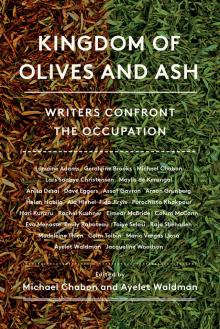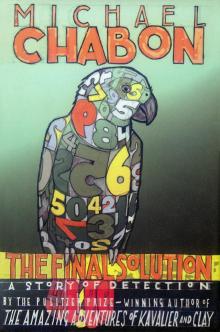- Home
- Michael Chabon
Kingdom of Olives and Ash: Writers Confront the Occupation Page 27
Kingdom of Olives and Ash: Writers Confront the Occupation Read online
Page 27
When we asked the security forces what they were going to do about this, the police who had been watching it said that they had not seen it. A number of army officers then appeared and made desultory enquiries, but they did not ask us for statements or for a description of the assailant.
In a place called Qawawwis in the South Hebron Hills on a Saturday morning in July 2016, a Palestinian sheep farmer—whom I’ll call Ibrahim—has been detained by the army, whose soldiers keep the engines of four jeeps running while they work out what to do with him. On the other side of the jeeps is an Israeli outpost, which was founded in 1998.
The problem is this: while the farmer can graze his sheep on these uplands, which are his, there is one piece of land not fenced off, close to the outpost, which is disputed, on which his sheep are not entitled to go. Unfortunately, the grass there is more plentiful than the grass on the other side of a small path. So the sheep have gone there to graze. In order to remove his sheep from this small piece of land, the farmer has had to walk on the disputed land.
It is clear that the sheep will always want to go to this piece of grass, and the farmer knows this will bring trouble.
There is no suggestion that Ibrahim is a security threat. His problem, effectively, is that he is Palestinian. His family has been using this land for generations.
There is no doubt this morning that the farmer has set foot on this disputed land, but it is hard to think of how he could have removed his sheep from the land without stepping on it. The army waits for the police to come.
The sun is hot. Hours go by. The farmer talks about his fear of the people in the outposts and of the army. He has been in hospital, he says, five times arising from injuries received at the hands of the settlers and the army. He alleges that while detained by the army on a previous occasion he was not only beaten up but also stabbed lightly with a knife. The settlers, he says, also attack his sheep.
Obviously, in another country, he could call the police, but he lives under military law, and the police and army support the settlers in the outpost who live under civil law, but in fact the settlers live as though there is no law at all.
Ibrahim, who lives nearby in a small makeshift hut, has seventeen people in his family. The aim of both the settlers and the authorities is for this man and his family to leave here, to move to one of the cities, such as Yatta, in Area A, which is, as a result of the Oslo accords, under the rule of the Palestinian Authority. (Area A, indeed, is set aside for Palestinians, and a system of transport had been designed so that Israelis never have to travel through or even see most Palestinian towns and cities.)
This morning is another small moment in the slow harassment of Ibrahim. The land around is rocky, the area is remote and desolate looking and also very beautiful. There is something almost comic about the scene, how serious the young army men look as they gravely walk back and forth as the sheep gently graze away from disputed land, as the piece of disputed land which is causing all this trouble appears not much larger than a suburban garden.
It becomes less comic in the farmer’s hut when one of his family members shows me his plastic stomach, the result, he says, of being shot by one of the settlers when he was grazing sheep in 2001, three years after the settlers arrived. He spent, he says, fifty-four days in an Israeli hospital and was finally taken to Iraq for a new stomach. There was, he says, no action taken against the settler who shot him.
Nearby, there is another Palestinian family whose house and farm buildings have recently been demolished, the demolition once more having been invoked by antiquated law. The scene is like a disaster area. Since it is midday, the sun is fierce in the sky, and the family must take shelter in one small makeshift tent. Some of the young women are also sheltering under an old truck. To rebuild will take time and ingenuity, as no machinery will be allowed to approach the site. Everything will have to be done by hand, with the risk that any new building will also be demolished.
Once more, there is no question of the family here, who are farmers, being a security risk. The problem is that they are too close to the Israeli settlement of Susya and too close to an outpost. The aim, once more, is to get them to leave.
When I ask one of the older men where the family originally came from, he tells me that he used to live inside Israel until 1948. After 1948, the family moved to Susiya al-Qadim, where they lived in caves. But in 1985 archaeologists came. For about a year, the man says, they remained in the caves while the archaeologists worked, but the archaeologists then fenced off the area and evicted any Palestinians who were living there.
A few days earlier in another site close to an Israeli settlement in the South Hebron Hills, I had visited a Palestinian family whose cave, which they had built themselves, had been demolished by the Israeli army. They were now living in a makeshift tent. Once more, when I asked them where they had originally come from, they said that they had lived in the caves in Susiya al-Qadim but had been moved in 1986 by the archaeologists who blocked the entrance to their cave with stones.
Susiya al-Qadim is now an archaeological park, a National Heritage Site. A brochure describes it as an “Ancient Jewish Town” and offers the site for “Weddings and Bar/Bat Mitzvah ceremonies in the ancient synagogue courtyard.” It also advertises a “covered event hall [which] holds up to 150 people.”
A cave in which audiovisual material is now displayed was the cave where the family whose cave was later demolished by the Israeli army had lived. The son of that family, Nasser Nawaja, now the father of three children, was born in the cave where there are now benches where visitors can sit to watch a video.
The site itself is a fascinating example of an early Jewish settlement. The synagogue was built between the fourth and the seventh centuries and was in use until the ninth century. The floor of the synagogue includes a mosaic in Hebrew. The contours of the site provides valuable clues about Jewish social patterns and religious rites centuries after the destruction of the Second Temple.
Although on the site itself there is a single reference to a mosque and there is a clearly marked outline of where the mosque was situated, there is no mention of the mosque in the promotional brochure. Although it has been suggested that Arabic inscriptions were also found at the site, there is nothing about this at the site itself or in the brochure. Nor is there any mention of who was living on the site at the time of the excavations.
Instead, the brochure suggests that Susiya was a sort of prototype for a modern Jewish settlement. For example: “In attaching the houses one to the other and creating a joint external wall a sense of security and defense against the desert dwellers was obtained.” This suggests that the Jewish inhabitants of Susiya were under attack in some way, and yet there is no evidence anywhere in the site of violence or violent attack. The site seems to have been abandoned by its Jewish population rather than attacked.
When the brochure reads, “It is probable that all of the town’s inhabitants took part in the construction of the defense belt,” it is hard to imagine what evidence the writer could have for this, but it is easy to read this as a sign that the Jewish people who lived here in the distant past organized building communally, as though Susiya were an early kibbutz, or indeed an early outpost or settlement.
There are several references in the brochure to “security,” and one to “the high security needs of the inhabitants.” But the brochure gives no evidence of what these needs might have been and nothing at all about what the excavation of the mosque shows, or what the very existence of such a Jewish village in a time of Islamic rule might imply.
It is clear that the heritage of Susiya, while mainly Jewish, is also complex and multilayered. The ghosts that walk on these old stones are not merely Jewish ones. But the archaeologists are working in a time when re-creating the past and invoking its power and its echoing presence are crucial weapons in the efforts to make the settlers feel that they have returned to a place that was once theirs. They do not wish to know that Susiya, like most other place
s in the world, also once belonged to other people too.
Indeed, the creation of the park itself involved the expulsion of Palestinian families who are, thirty years after their eviction, still living in appalling conditions nearby. Moving the Palestinians out in order to open such an impressive and important site to visitors might seem reasonable, but it appears less so since an outpost of Israeli settlers has arrived to live inside the boundaries of the park. The settlers are there under the full protection of the Israeli army.
The idea that the Israelis care about every single inch of this territory and have plans for it is striking. The soldiers and the settlers who watched the lone shepherd that morning in July 2016 viewed his brief presence in a small piece of grassland with immense seriousness.
Sometimes, the Israelis’ sheer attention to detail and the thoroughness of the security forces and planners are impressive. It is easy to feel this, for example, in Hebron itself, easy to feel how careful and detailed the security system is until someone takes you into the city by a series of narrow paths, across waste ground, thus avoiding checkpoints. And then you realize that the system merely looks impressive, and is designed to impress, but it doesn’t really work and is, in fact, not designed to work. It is there for other reasons.
It is easy, for example, for Palestinians to enter parts of Hebron banned to them by using the Muslim graveyard. Nobody actually cares whether the Palestinians enter or not. But the stores and markets are closed; the doors of the Palestinian shops are sealed up. The place has been brutalized. The army is moving up and down the empty streets. That part of the plan has been carried out with care and efficiency. A society that once prided itself on making the desert bloom is now involved in making a ghost town of a great old city.
In the weeks before I went to Hebron, a young girl had been murdered by a Palestinian in the Kiryat Arba settlement just outside the city, and another Israeli had been murdered on the main road leading to town. The government response was to seal off parts of Hebron lived in by Palestinians and seal off other towns and villages as well. One Saturday, I noticed an Israeli bulldozer creating ditches, all the more efficiently to close off a field that led to a village. Three days later, as I passed again, I saw a truck bringing supplies to the village driving blithely across the same field that had been sealed off. It had not really been sealed off. The bulldozing had all been done for show.
The city of Jericho, like Ramallah, is in Area A, which means that it is under the control of the Palestinian Authority. With a population of twenty-three thousand, it is the oldest inhabited city in the world. A tourist brochure outlines the rich and complex heritage of the city, which includes Hellenistic and Roman remains, signs of Byzantine and Islamic habitation, and a synagogue from the sixth through seventh centuries AD.
Because of its mild climate in the winter, Jericho has become a place of refuge for rich Palestinians who live in Ramallah and East Jerusalem. On the outskirts of the city, some very grand modern houses have been built by Palestinians who have money. Also, because Palestinians are not allowed to use the airport near Tel Aviv and must travel to Jordan and use the airport at Amman, Jericho is an important stop along the way.
The place was not the haven I imagined, however, but an ordinary, slightly sleepy town with a main square, the old mud houses replaced by modern buildings. Nonetheless, I did find a small, relaxed café, plus an efficient barber shop.
On the outskirts of Jericho, however, are the ruins of Hisham’s Palace, a massive desert outpost created by the Arab Umayyad caliph Hisham Bin Abd al-Malik, from the eighth century, with signs of a sophisticated heating system, some sculpture, and some exquisite mosaic work, including the very beautiful Tree of Life, with two gazelles on the left-hand side of the tree standing alone and free but the gazelle on the right-hand side being attacked savagely by a lion.
When the guide told me that the flower motif at the edge of the Tree of Life was replicated in the mosaic floor of a synagogue nearer the city, I was interested in this, but the synagogue is now closed and cannot be visited.
As in Ramallah, there are conflicting versions of what the Oslo accords have meant. On the one hand, the accords have resulted in the withdrawal of the Israeli army and the building of hospitals and schools in Jericho. (And in Ramallah, they have meant the arrival of banks, with quick mortgages and easy credit, and thus a sort of boom.)
But on the other hand, in Jericho, once I began to talk to people, I discovered that many problems persist, not least the complex problem of getting across the border into Jordan, but also the problem of who owns the water here and who is allowed to make use of it.
Palestinians have to travel to Amman to use the airport, a journey that the Israelis make difficult. There are two checkpoints between Jericho and the border, and luggage must be transported separately. A journey of ten kilometres thus takes hours rather than minutes.
In the streets of Ramallah and Jericho, there is the illusion of freedom, and in Ramallah now there are some fine restaurants. It is when Palestinian citizens attempt to exercise their freedom—including the freedom to leave the country and then come back—that the problems begin. And the problems also begin with water.
There are five water springs close to Jericho. The city can use one of those, while the Israeli settlers, of whom there are six thousand in the Jordan Valley, use the other four. Even in Area A, which is, in theory, controlled by the Palestinian Authority, the Israelis do not allow Palestinians to dig wells. Since the Jordan Valley is fertile and valuable, more than 80 percent of it remains in Area C, under Israeli control. In 2011, according to the Israeli NGO B’Tselem, “the average household water allocation was 450 litres per person per day for the Israeli settlers and 60 litres per person per day for Palestinians. (The World Health Organization recommends a hundred litres per person per day.)”
Since only the city of Jericho itself is in Area A, then Area C surrounds certain parts of it. Many of the houses of the older Palestinian inhabitants in Area C that are close to Jericho are under demolition orders, and some indeed have been demolished recently and left without electricity and water.
Jericho will be an enclave, surrounded by Israeli power and Israeli settlements. Slowly, then, as Israeli outposts and the slow harassment of the Palestinian population by the army and the authorities increase, as the West Bank becomes two countries, with some roads essentially for Israelis only and others only for Palestinians, with settlements and outposts surrounded by the army for protection, with 62 percent of the West Bank under full Israeli control, with just a few towns and cities under Palestinian Authority control, the West Bank will have been successfully occupied, the Palestinians will have been surrounded and corralled.
What is essential then is that lines of communication between Israeli leaders, even leaders in civil society, and those who lead their communities in the Palestinian-controlled areas be kept open. There will, at some time in the future, have to be dialogue, an appreciation of what the history of suffering has been and has meant for both sides.
Instead, there is silence, suspicion, and distance.
On my last day in Israel, as I waited in the airport, I picked up a copy of the Jerusalem Post. At the bottom of page 3, there was a headline: “FM blocks Beilin from meeting Abbas.”
The article said that Yossi Beilin, who had been involved in the negotiations which led to the Geneva Initiative of 2003, as well as the Oslo accords (Geneva was a failed initiative which would have involved an almost total Israeli withdrawal from the West Bank, a nonmilitarized Palestinian state, and Jerusalem divided between Israel and Palestine) goes with others from the Israeli side of those negotiations “every month or so to meet with their Palestinian counterparts.”
“We always get proper authorization [since Israelis need this to legally enter Ramallah], and we have never been turned down except during war like in July 2014,” Beilin said.
Beilin’s application to visit Ramallah was turned down by the Israeli Defense Min
ister for “security reasons.” Neither Beilin nor anyone else could think what these “security reasons” could be. Stopping Yossi Beilin, a figure whose record in seeking agreement between Israel and Palestine has been brave and distinguished, from meeting with members of the Palestinian Authority seems counterproductive and petty.
Like much else that is happening in the West Bank, including things I witnessed while I was there, this may satisfy some set of short-term goals, but it is hard to see any long-term strategy involved which will bring justice or create anything other than hardship and bitterness. The strategy seems merely tactical, and it is hard to see the tactics as anything other than cruel and self-serving and shortsighted.
The End of Reasons
Eimear McBride
I had not thought about the world for a very long time and, of all places, here had seemed easier to ignore. But I am driving down to Jericho now, and, for the first time in a week, I breathe. Not because I have become accustomed to the hassle of checkpoints or seeing young men and women, still teenagers some, looking out at me from behind guns that they know how to use. Not because I have stopped noticing how grown men and women close themselves up behind a mask of quietude in order to cope with their every movement being at the whim of those same youngsters. The red signs at every turnoff into the West Bank, warning that the government forbids entry and that entry is dangerous, have not ceased, in a whole variety of selfish and unselfish ways, to alarm me. Quite to the contrary, I am only beginning to see, learning how to look, and my sense of alarm is off the charts.

 McSweeney's Mammoth Treasury of Thrilling Tales
McSweeney's Mammoth Treasury of Thrilling Tales The Amazing Adventures of Kavalier & Clay
The Amazing Adventures of Kavalier & Clay The Yiddish Policemen's Union
The Yiddish Policemen's Union Wonder Boys
Wonder Boys Manhood for Amateurs
Manhood for Amateurs Kingdom of Olives and Ash: Writers Confront the Occupation
Kingdom of Olives and Ash: Writers Confront the Occupation Gentlemen of the Road: A Tale of Adventure
Gentlemen of the Road: A Tale of Adventure A Model World and Other Stories
A Model World and Other Stories Pops: Fatherhood in Pieces
Pops: Fatherhood in Pieces McSweeney's Enchanted Chamber of Astonishing Stories
McSweeney's Enchanted Chamber of Astonishing Stories Summerland
Summerland Telegraph Avenue
Telegraph Avenue The Final Solution
The Final Solution The Mysteries of Pittsburgh
The Mysteries of Pittsburgh Werewolves in Their Youth
Werewolves in Their Youth Bookends
Bookends Fight of the Century
Fight of the Century Maps and Legends
Maps and Legends The Amazing Adventures of Kavalier & Clay (with bonus content)
The Amazing Adventures of Kavalier & Clay (with bonus content) Kingdom of Olives and Ash
Kingdom of Olives and Ash Pops
Pops Gentlemen of the Road
Gentlemen of the Road The Final Solution: A Story of Detection
The Final Solution: A Story of Detection Telegraph Avenue: A Novel
Telegraph Avenue: A Novel